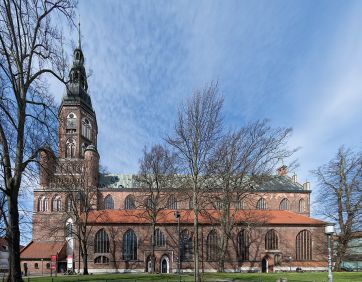The Race for the Sacrificial Money

(See Mierälius Part II, p. 407. Poetic treatments are in Freyberg, “Pommersche Sagen”, Pasewalk 1835 p. 32 and in Ziehnert Vol. I p. 131ff)
There once was a chapel dedicated to Saint Gertrude in front of the city of Greifswald. This chapel was a popular pilgrimage site. On one particular holy day dedicated to the saint, a lot of money had been donated there. It was the duty of the priest in charge of the shrine to deliver this sacrificial money to the church treasury. But the Devil of Greed came over him, and he decided to keep the money for himself. But since he was also an otherwise brazen and faithless man, he took the image of Saint Gertrude from the altar, put it next to the entrance of the chapel opposite to himself, and spoke to it: “Now we shall see whom the sacrificial money belongs to. We will both race towards the altar, and whoever gets there first shall keep it!” After he had spoken in this manner, he ran towards the altar. But behold, the wooden image suddenly came alive, ran past him, and arrived before him. However, this miracle did not startle the evildoer. He took the image from the altar a second time, put it at the entrance once more, and again raced for the sacrificial money lying on the altar. And the image again ran after him and overtook him a second time. But this, too, did not deter him. He fetched the image for the third time, put it next to the entrance, and ran towards the altar. This time he alone reached it, for Saint Gertrude remained in place and wept bitter tears. The godless priest now took the money with him and carried it home, but he fell deeply ill the very next night. He was dead three days later, and was buried on the Gertrudenkirchhof graveyard.
But the next night, the Devil appeared in the graveyard during the midnight hour. He knocked on the grave of the priest and called inside: “Stand up, preacher, and run a race with me.” Then the dead man had to rise from the coffin, and when he exited the grave, the Devil grabbed him with his claws and carried him away. When they came near the chapel, the priest grabbed the door latch and wanted to hold onto it, for he thought that the Devil would have to let him go if he did so. But it was to no avail, for the Devil pried him off and carried him away over the graveyard walls and into his infernal realm. The miller living in the neighboring windmill witnessed all this and reported it to the authorities. When the location was closely examined, traces of the priest’s fingernails could still be seen in the door of the chapel from when the priest, afraid of his life, had tried to hang on. Deep footsteps by the Devil had been stomped into the ground, and the grass surrounding the scene had been burned. All these traces remained and were visible for a long time until the chapel was torn down and fortifications were built at the site.
But according to another legend, the Devil hanged the priest on a blade of the windmill, which was standing still at the time. Since that time, the rotary axle always turned counterclockwise instead of clockwise, and that incident supposedly did not occur in St. Gertrude’s chapel, but in the St. Nicolai Church which was built in 1298.
Note: For a similar legend, see Nr. 400 on p. 251.
Source: Grässe - Sagenbuch des preussischen Staats - Zweiter Band, p. 449
Geographic Coordinates: 54° 5' 42.03" N, 13° 23' 30.69" E54° 5' 45.53" N, 13° 23' 40.94" E54° 5' 44.94" N, 13° 22' 37.64" E